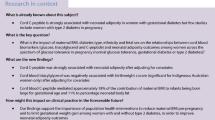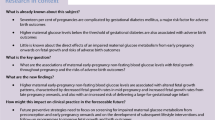Abstract
Background/objectives
To study whether FGF21 was present in cord blood and explore its relationship with maternal variables and postnatal growth.
Subjects and methods
The study included 157 pregnant women at the beginning of the third trimester; 79 with gestational diabetes (GDM), 78 with normal glucose tolerance (NGT), and their offspring. Glucose metabolism was assessed by oral glucose tolerance test. Insulin resistance was assessed by homeostasis model assessment index–insulin resistance (HOMA-IR). FGF21 was determined in maternal plasma drawn at recruitment and in cord blood obtained at delivery. Offspring weight and height was assessed at birth and at 12, 24 and 48 months.
Results
Maternal FGF21 was higher in gestational diabetes than in the normal glucose-tolerant group, whereas similar cord blood FGF21 levels were observed in both groups. Lower cord blood FGF21 was strongly positively correlated with maternal circulating levels. This relationship was independent of mother’s prepregnancy body mass index (BMI), glucose levels and HOMA-IR. Although maternal FGF21 levels were correlated with prepregnancy BMI and HOMA-IR index, no relationship was observed between FGF21 and birth weight. However, cord blood FGF21 levels were correlated with BMI Zeta Score at 12 and 24 months, and this relationship became stronger when only the NGT group was analyzed.
Conclusion
FGF21 is present in human cord blood, and its levels are closely correlated with maternal levels. The association observed between cord blood FGF21 and postnatal BMI may suggest a potential role during intrauterine life that may influence future metabolic imbalance.

Similar content being viewed by others
References
Kharitonenkov A, Shiyanova TL, Koester A, Ford AM, Micanovic R, Galbreath EJ et al (2005) FGF-21 as a novel metabolic regulator. J Clin Invest 115(6):1627–1635
Nishimura T, Nakatake Y, Konishi M, Itoh N (2000) Identification of a novel FGF, FGF-21, preferentially expressed in the liver. Biochem Biophys Res Commun 1492:203–206
Fon Tacer K, Bookout AL, Ding X, Kurosu H, John GB, Wang L et al (2010) Comprehensive expression atlas of the fibroblast growth factor system in adult mouse. Mol Endocrinol 24(10):2050–2064
Inagaki T, Dutchak P, Zhao G, Ding X, Gautron L, Parameswara V et al (2007) Endocrine regulation of the fasting response by PPARalpha-mediated induction of fibroblast growth factor 21. Cell Metab 5(6):415–425
Badman MK, Pissios P, Kennedy AR, Koukos G, Flier JS, Maratos-Flier E (2007) Hepatic fibroblast growth factor 21 is regulated by PPARalpha and is a key mediator of hepatic lipid metabolism in ketotic states. Cell Metab 5(6):426–437
Lundäsen T, Hunt MC, Nilsson L-M, Sanyal S, Angelin B, Alexson SEH et al (2007) PPARalpha is a key regulator of hepatic FGF21. Biochem Biophys Res Commun 360(2):437–440
Arner P, Pettersson A, Mitchell PJ, Dunbar JD, Kharitonenkov A, Rydén M (2008) FGF21 attenuates lipolysis in human adipocytes—a possible link to improved insulin sensitivity. FEBS Lett 582(12):1725–1730
Wente W, Efanov AM, Brenner M, Kharitonenkov A, Köster A, Sandusky GE et al (2006) Fibroblast growth factor-21 improves pancreatic beta-cell function and survival by activation of extracellular signal-regulated kinase 1/2 and Akt signaling pathways. Diabetes 55(9):2470–2478
Coskun T, Bina HA, Schneider MA, Dunbar JD, Hu CC, Chen Y et al (2008) Fibroblast growth factor 21 corrects obesity in mice. Endocrinology 149(12):6018–6027
Xu J, Lloyd DJ, Hale C, Stanislaus S, Chen M, Sivits G et al (2009) Fibroblast growth factor 21 reverses hepatic steatosis, increases energy expenditure, and improves insulin sensitivity in diet-induced obese mice. Diabetes 58(January):250–259
Zhang X, Yeung DCY, Karpisek M, Stejskal D, Zhou Z, Liu F et al (2008) Serum FGF21 levels are increased in obesity and are independently associated with the metabolic syndrome in humans. Diabetes 57(May):1246–1253
Chavez A, Molina-Carrion M, Abdul-Ghani M, Folli F, DeFronzo R, Tripathy D (2009) Circulating fibroblast growth factor-21 is elevated in impaired glucose tolerance and type 2 diabetes and correlates with muscle and hepatic insulin resistance. Diabetes Care 32:1542–1546
Chen C, Cheung B, Wang Y, Law L, Leung K, Wat N et al (2011) High plasma level of fibroblast growth factor 21 is an independent predictor of type 2 diabetes. Diabetes Care 34:11–13
Catalano PM, Hauguel-De Mouzon S (2011) Is it time to revisit the Pedersen hypothesis in the face of the obesity epidemic? Am J Obstet Gynecol 204(6):479–487
Nitert MD, Barrett HL, Kubala MH, Scholz Romero K, Denny KJ, Woodruff TM et al (2014) Increased placental expression of fibroblast growth factor 21 in gestational diabetes mellitus. J Clin Endocrinol Metab 99(4):E591
Tan BK, Sivakumar K, Bari MF, Vatish M, Randeva HS (2013) Lower cerebrospinal fluid/plasma fibroblast growth factor 21 (FGF21) ratios and placental FGF21 production in gestational diabetes. PLoS One 8(6):e65254
Wang D, Zhu W, Li J, An C, Wang Z (2013) Serum concentrations of fibroblast growth factors 19 and 21 in women with gestational diabetes mellitus: association with insulin resistance, adiponectin, and polycystic ovary syndrome history. PLoS One 8(11):e81190
Stein S, Stepan H, Kratzsch J, Verlohren M, Verlohren H-J, Drynda K et al (2010) Serum fibroblast growth factor 21 levels in gestational diabetes mellitus in relation to insulin resistance and dyslipidemia. Metabolism 59(1):33–37
GEDE. Grupo Español de Diabetes y Embarazo (2006) Guía asistencial de diabetes mellitus y embarazo (3a edición). Av en Diabetol 22:73–87
National Diabetes Data Group (1979) Classification and diagnosis of diabetes mellitus and other categories of glucose intolerance. Diabetes 28:1039–1057
Sobradillo B, Aguirre A, Aresti U, Bilbao A, Fernandez-Ramos C, Lizárraga A, et al. (2014) Curvas y Tablas de Crecimiento. Estudios longitudinal y transversal. Bilbao: Fundación Faustino Orbegozo. http://www.aepap.org/pdf/f_orbegozo_04.pdf. Accessed 25 June 2014
Matthews DR, Hosker JP, Rudenski AS, Naylor BA, Treacher DF, Turner RC (1985) Homeostasis model assessment: insulin resistance and beta cell function from fasting plasma glucose and insulin concentrations in man. Diabetologia 28:412–419
Yang C, Jin C, Li X, Wang F, McKeehan WL, Luo Y (2012) Differential specificity of endocrine FGF19 and FGF21 to FGFR1 and FGFR4 in complex with KLB. PLoS One 7(3):e33870
Suzuki M, Uehara Y, Motomura-Matsuzaka K, Oki J, Koyama Y, Kimura M et al (2008) BetaKlotho is required for fibroblast growth factor (FGF) 21 signaling through FGF receptor (FGFR) 1c and FGFR3c. Mol Endocrinol 22(4):1006–1014
Hondares E, Rosell M, Gonzalez FJ, Giralt M, Iglesias R, Villarroya F et al (2011) Hepatic FGF21 expression is induced at birth via PPARα in response to milk intake and contributes to thermogenic activation of neonatal brown fat. Cell Metab 11(3):206–212
Hondares E, Gallego-Escuredo JM, Flachs P, Frontini A, Cereijo R, Goday A et al (2014) Fibroblast growth factor-21 is expressed in neonatal and pheochromocytoma-induced adult human brown adipose tissue. Metabolism 63(3):312–317
Xu L, Ping F, Yin J, Xiao X, Xiang H, Ballantyne CM et al (2013) Elevated plasma sparc levels are associated with insulin resistance, dyslipidemia, and inflammation in gestational diabetes mellitus. PLoS One 8(12):e81615
Stepan H, Kley K, Hindricks J, Kralisch S, Jank A, Schaarschmidt W et al (2013) Serum levels of the adipokine fibroblast growth factor-21 are increased in preeclampsia. Cytokine 62(2):322–326
Noctor E, Crowe C, Carmody LA, Kirwan B, O’Dea A, Glynn LG, et al (2014) ATLANTIC-DIP: prevalence of metabolic syndrome and insulin resistance in women with previous gestational diabetes mellitus by international association of diabetes in pregnancy study groups criteria. Acta Diabetol. doi:10.1007/s00592-014-0621-z
Reinehr T, Woelfle J, Wunsch R, Roth CL (2012) Fibroblast growth factor 21 (FGF-21) and its relation to obesity, metabolic syndrome, and nonalcoholic fatty liver in children: a longitudinal analysis. J Clin Endocrinol Metab 97(6):2143–2150
Savona-Ventura C, Vassallo J, Marre M, Karamanos BG (2012) Hyperglycaemia in pregnancy in Mediterranean women. Acta Diabetol 49(6):473–480
Ignell C, Shaat N, Ekelund M, Berntorp K (2013) The impact of ethnicity on glucose homeostasis after gestational diabetes mellitus. Acta Diabetol 50(6):927–934
Sletner L, Nakstad B, Yajnik CS, Mørkrid K, Vangen S, Vårdal MH et al (2013) Ethnic differences in neonatal body composition in a multi-ethnic population and the impact of parental factors: a population-based cohort study. PLoS One. 8(8):e73058
Acknowledgments
P-GL is grateful to ACD for the “Ajut per a la recerca en diabetis modalitat clínica 2013.” SF-V acknowledges support from the “Miguel Servet” tenure track program (CP10/00438), from the Fondo de Investigación Sanitaria (FIS), co-financed by the European Regional Development Fund (ERDF). GL is supported by a “Rio Hortega” research fellowship (CM12/00044) from the Instituto de Salud Carlos III. The authors are grateful to Miriam Campos and Lluís Gallart from the Biobank at Joan XXIII hospital for their help in laboratory work and to Pilar Hernandez from the IISPV for her help with statistical analysis. This work was supported by grants FIS PI 12/0717 to AM, Fondos FEDER and CIBER de Diabetes y Enfermedades Metabólicas asociadas CIBERDEM (CB07/08/0012), SAF2012-36186 and CP10/00438 to SF-V (Spanish Ministry of Economy and Competitiveness) and Ajut per a la recerca en diabetis modalitat clínica 2013 to PG-L. CIBERDEM de Diabetes y Enfermedades Metabólicas asociadas (CB07708/0012) is an initiative of the Instituto de Salud Carlos III.
Conflict of interest
Ana Megia, Pilar Gil-Lluís, Silvia Näf, Victoria Ceperuelo-Mallafre, José Miguel González-Clemente, Gemma Llauradó, Catalina Nuñez-Roa, Kelly Roche, Mónica Ballesteros, Rosa-Elena Yañez, Sonia Fernandez-Veledo and Joan Vendrell declare that they have no conflict of interest.
Ethical standard
Study was approved by the Hospital Research Ethics Committee.
Statement of human and animal rights
All procedures followed were in accordance with the ethical standards of the responsible committee on human experimentation (institutional and national) and with the Helsinki Declaration of 1975, as revised in 2008.
Statement of informed consent
Informed consent was obtained from all patients for being included in the study.
Author information
Authors and Affiliations
Corresponding author
Additional information
Managed by Massimo Federici.
Ana Megia and Pilar Gil-Lluis have been contributed equally to this work.
Rights and permissions
About this article
Cite this article
Megia, A., Gil-Lluis, P., Näf, S. et al. Cord blood FGF21 in gestational diabetes and its relationship with postnatal growth. Acta Diabetol 52, 693–700 (2015). https://doi.org/10.1007/s00592-014-0705-9
Received:
Accepted:
Published:
Issue Date:
DOI: https://doi.org/10.1007/s00592-014-0705-9




